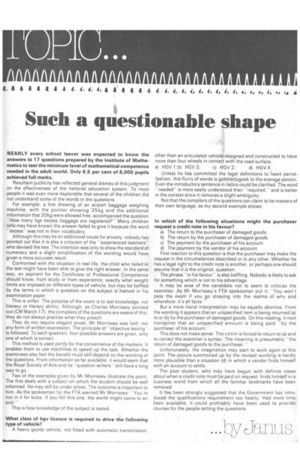Such a questionable shape
Page 82

If you've noticed an error in this article please click here to report it so we can fix it.
NEARLY every school leaver was expected to know the answers to 17 questions prepared by the Institute of Mathematics to test the minimum level of mathematical competence needed in the adult world. Only 6.5 per cent of 8,000 pupils achieved full marks.
Resultant publicity has reflected general dismay at this judgment on the effectiveness of the national education system. To most people it was even more deplorable that several of the children did not understand some of the words in the questions.
For example, a line drawing of an airport baggage weighing machine, with the pointer showing 35kg and the additional information that 20kg were allowed free, accompanied the question "How many kgs excess baggage are registered?" Many children who may have known the answer failed to give it because the word "excess"' was not in their vocabulary.
Although this may be an additional cause for anxiety, nobody has pointed out that it is also a criticism of the "experienced teachers" who devised the test. The intention was only to show the standard of numeracy and a slight simplification of the wording would have given a more accurate result.
Confronted with the situation in real life, the child who failed in the test might have been able to give the right answer. In the same way, an aspirant for the Certificate of Professional Competence should know, from study or from experience, exactly what weight limits are imposed on different types of vehicle, but may be baffled by the terms in which a question on the subject is framed in his examination paper.
This is unfair. The purpose of the exam is to test knowledge. not literacy or literary ability. Although, as Charles Morrissey pointed out (CM March 1 7), the compilers of the questions are aware of this, they do not always practise what they preach.
They do not require elegant prose, Mr Morrissey was told, nor any form of written expression. The principle of -objective testingis followed. To each question, four possible answers are given, only one of which is correct.
This method is used partly for the convenience of the markers It enables them to use machines to speed up the task. Whether the examinees also feel the benefit must still depend on the wording of the questions. From information so far available, it would seem that the Royal Society of Arts and its -question writers" still have a long way to go.
Two of the examples given by Mr Morrissey illustrate the point. The first deals with a subject on which the student should be well informed. He may still be under stress. The outcome is important to him. As the spokesman for the FTA warned Mr Morrissey: "You' re not in it for kicks. If you fail this one, the world might come to an end."
This is how knowledge of the subject is tested What class of hgv licence is required to drive the following type of vehicle?
A heavy goods vehicle, not fitted with automatic transmission, other than an articulated vehicle designed and constructed to have more than four wheels in contact with the road surface.
a) HGV 1 ;b) HGV 3; HGV 2: d) HGV 4
Unless he has committed the legal definitions to heart parrotfashion, this flurry of words is gobbledygook to the average person. Even the introductory sentence in italics could be clarified. The word "needed" is more easily understood than "required,and is better in the context since it removes a slight ambiguity.
Not that the compilers of the questions can claim to be masters of their own language, as my second example shows• In which of the following situations might the purchaser request a credit note in his favour?
a) The return to the purchaser of damaged goods.
b) The return by the purchaser of damaged goods.
C) The payment by the purchaser of his account.
d) The payment by the vendor of his account.
First reaction to this question is that the purchaser may make the request in the circumstances described or in any other. Whether he has a legal right to the credit note is another, or perhaps one should assume that it is the original, question.
The phrase -in his favouris also baffling. Nobody is likely to ask for something which is not to his advantage.
It may be wise of the candidate not to seem to criticise the examiner. As Mr Morrissey's FTA spokesman put it "You won't pass the exam if you go straying into the realms of why and wherefore: it's all facts."
But a more literal interpretation may be equally abortive. From the wording it appears that an unspecified item is being returned (a) to or (b) by the purchaser of damaged goods. On this reading, it next transpires that an unspecified amount is being paid "by the purchaser of his account.
This does not make sense. The victim is forced to return to (a) and to correct the examiner's syntax. The meaning is presumably "the return of damaged goods to the purchaser."
Unfortunately, the imagination may start to work again at this point. The picture summoned up by the revised wording is hardly more plausible than a situation (d) in which a vendor finds himself with an account to settle.
The poor student, who may have begun with definite views about when a credit note must be paid on request, finds himself in a business world from which all the familiar landmarks have been removed.
It has been strongly suggested that the Government has introduced the qualifications requirement too hastily. Had more time been available, it could profitably have been used to provide courses for the people setting the questions.
• • • oyJazi-u_s








































































































































